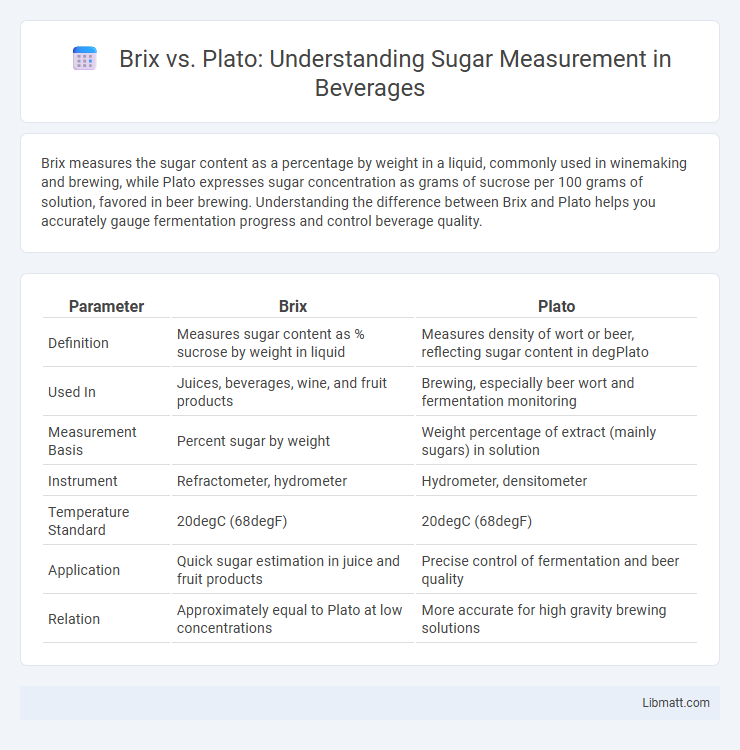Brix measures the sugar content as a percentage by weight in a liquid, commonly used in winemaking and brewing, while Plato expresses sugar concentration as grams of sucrose per 100 grams of solution, favored in beer brewing. Understanding the difference between Brix and Plato helps you accurately gauge fermentation progress and control beverage quality.
Table of Comparison
| Parameter | Brix | Plato |
|---|---|---|
| Definition | Measures sugar content as % sucrose by weight in liquid | Measures density of wort or beer, reflecting sugar content in degPlato |
| Used In | Juices, beverages, wine, and fruit products | Brewing, especially beer wort and fermentation monitoring |
| Measurement Basis | Percent sugar by weight | Weight percentage of extract (mainly sugars) in solution |
| Instrument | Refractometer, hydrometer | Hydrometer, densitometer |
| Temperature Standard | 20degC (68degF) | 20degC (68degF) |
| Application | Quick sugar estimation in juice and fruit products | Precise control of fermentation and beer quality |
| Relation | Approximately equal to Plato at low concentrations | More accurate for high gravity brewing solutions |
Understanding Brix and Plato Scales
Brix and Plato scales both measure the sugar content in liquids, primarily used in brewing and winemaking to determine fermentation potential. The Brix scale quantifies the percentage of sugar by weight, while the Plato scale measures the density of dissolved solids as degrees Plato, closely correlated to sugar concentration. Understanding these scales helps you accurately assess the specific gravity and potential alcohol yield of your brew or wine.
Historical Background of Brix and Plato
The Brix and Plato scales both originated in the 19th century as methods to measure sugar content in liquids, essential for brewing and winemaking. Brix, developed by Adolf Brix in 1870, measures the percentage of sucrose by weight in a solution, while Plato, created by Fritz Plato in the early 1900s, provides a similar metric tailored specifically for brewing applications. Both scales remain industry standards, with Plato often favored by brewers for its precise correlation to wort extract levels.
The Science Behind Sugar Measurement
Brix and Plato scales both measure sugar concentration in liquid solutions, crucial for industries like brewing and winemaking. The Brix scale quantifies the percentage of sucrose by weight in a solution, while Plato specifically measures extractable solids, primarily sugars, reflecting degrees of fermentation. Understanding the distinction enables precise control of fermentation processes, ensuring consistent product quality and optimized flavor profiles.
Conversion Between Brix and Plato
The conversion between Brix and Plato scales is essential for accurate measurement of sugar content in brewing and winemaking, as both quantify the percentage of sucrose by weight but with subtle differences due to calibration methods. Typically, 1 degree Plato equals approximately 1.04 degrees Brix, enabling straightforward conversion using formulas such as Plato = Brix x 0.96. Understanding this conversion ensures precise monitoring of fermentation progress and optimal quality control in beverage production.
Applications in Brewing and Winemaking
Brix and Plato scales both measure sugar concentration in wort and grape must, crucial for predicting potential alcohol content in brewing and winemaking. Breweries often prefer Plato for its close alignment with specific gravity and fermentation control, while winemakers favor Brix due to its straightforward expression of sugar percentage. Accurate measurement using either scale ensures optimal fermentation management and desired final product quality in alcoholic beverage production.
Advantages of Using Brix
Brix offers the advantage of a straightforward numeric scale that directly represents sugar content in grams per 100 grams of solution, simplifying measurements for winemakers and brewers. Its widespread adoption in the food and beverage industry ensures compatibility with most refractometers and hydrometers, enhancing efficiency and accuracy in sugar concentration analysis. The ease of converting Brix values to potential alcohol or sweetness levels streamlines production decisions and quality control processes.
Benefits of the Plato Scale
The Plato scale offers precise measurement of wort density, enabling accurate estimation of potential alcohol content and fermentation progress in brewing. Using Plato enhances recipe consistency and quality control by providing standardized, easy-to-interpret values based on weight percentage of sucrose. Compared to Brix, the Plato scale is specifically tailored for brewing applications, resulting in improved process efficiency and product reliability.
Common Misconceptions and Errors
Confusing Brix and Plato scales often leads to measurement errors in brewing and winemaking, as both represent sugar concentration but use different calibration standards. A common misconception is treating Brix degrees as directly equivalent to Plato, despite Plato being slightly more accurate for describing extract weight in malt solutions. Misapplication of these scales can result in incorrect calculations of alcohol content and fermentation efficiency, highlighting the importance of understanding their distinct calibration and purposes.
Choosing the Right Scale for Your Needs
Choosing the right scale between Brix and Plato depends on the precision required for measuring sugar content in brewing or winemaking. Brix represents grams of sugar per 100 grams of solution, ideal for quick assessments in winemaking and juice industries, while Plato measures grams of extract per 100 grams of wort, providing more accuracy for brewers monitoring fermentation progress. Your decision should consider the specific application and the level of detail necessary for product consistency and quality control.
Brix vs Plato: Final Comparison and Recommendations
Brix and Plato both measure sugar content in brewing and winemaking but differ in scale and precision, with Plato providing a more precise indication of extract density in grams per 100 grams of solution. Brix is commonly used for fruit juices and simpler fermentations, while Plato is favored in professional brewing for accuracy in calculating original gravity and alcohol content. For detailed fermentation control and quality assurance, Plato is recommended, whereas Brix suits quick estimations and fruit ripeness assessments.
Brix vs Plato Infographic

 libmatt.com
libmatt.com